Director Q&A: No Payne, No Gain
The "Holdovers" filmmaker holds forth on eastern Midwesterners (i.e., New Englanders), Paul "No Comps" Giamatti, and making a '70s movie in 2023.
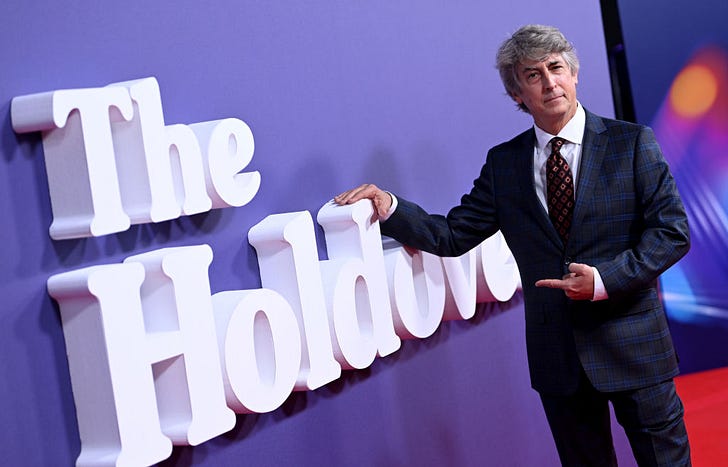
Alexander Payne has directed eight feature films over the past 27 years, each a small, spiky gem of comic character study. “Citizen Ruth” (1996), “Election” (1999), and “About Schmidt” (2002) — all written with Jim Taylor — fondly and mercilessly skewer various American types, but with “Sideways” (2004) and “The Descendants” (2011), a slight mellowing could be detected. “Nebraska” (2013), shot in Payne’s home state in wintry black and white, may be his richest, most plangent work, and “Downsizing” (2017) may be his oddest: A sprawling Pilgrim’s Progress with a wee Matt Damon at its center. His new film, “The Holdovers” (review here), finds the filmmaker in his prime (dis)comfort zone: A tale of a curmudgeonly schoolmaster (“Sideways” star Paul Giamatti) stuck over the holidays with an abandoned student (newcomer Dominic Sessa) and the campus cook (Da’Vine Joy Randolph). Small in scale but touching and gratifyingly funny, “The Holdovers” is Essential Payne: A story of humans in all their absurdities, told in a style that hides its own mastery.
Payne came to Boston this past Monday on a promotional swing and a screening of “The Holdovers” at the Somerville Theatre, which appears in the film as itself, creating a kind of M.C. Escher time-space wormhole for all those who were lucky enough to attend. Lucky for me, I had the privilege of hosting the post-screening Q&A that night, which unfortunately was not recorded for posterity. Lucky for you, I’d already interviewed Payne earlier in the day, and a version of that conversation, edited for length and clarity, follows.
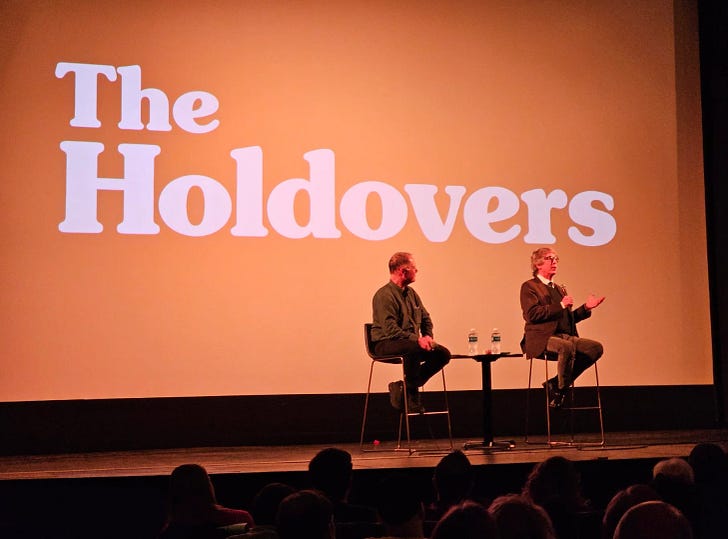
Ty Burr: Okay, so lead me through how you got involved in the project. It's been six years since “Downsizing.” I know you had a couple of other things on the burner.
Alexander Payne: One was very close. We were teed up to shoot in five days. Really lovely script. It was about a road trip of a Scandinavian writer and his daughter tracing the footsteps of the Vikings and Norwegians from Newfoundland to Minnesota. And it was loosely based on a nonfiction article by [Karl Ove] Knausgård that was in The New York Times Magazine. It was cast with Mads Mikkelsen in the lead, and Knausgård wound up putting the kibosh on it about five days before shooting.
TB: Why?
AP: There had been some language in his contract about approval, and he read the script and thought that the daughter character, which was fictitious, too coincidentally resembled his own daughter. And he wouldn't stand for it. He threatened us with lawsuits and all sorts of hideousness, and I could not make a film under those conditions. But I wish to return to that story one day.
TB: So you would have made that pre-COVID?
AP: Yeah, that's the thing that killed me. It was going to shoot from, like, September to December of 2019. And I could have been editing throughout the pandemic.
TB: When did this one heat up?
AP: I had had the idea for this about a dozen years ago, based on a 1935 French Marcel Pagnol film [“Merlusse”]. The same setup. Henri Poupon is the lead – like the mustard. I just thought that was a darn good premise for a movie. But I hadn't done anything with it. And I knew when I did want to do something with it, I had to come out here and tour schools and talk to people and kind of soak up the atmosphere. I can't just make it up out of my head.
TB: Right.
AP: Five years later, I was submitted a pilot script for a TV series that would take place in a boarding school. And it was very well written. And I called the writer and said, I've just read your script. I don't want to do it, but would you consider fashioning a feature film with this idea in that world? And he happened to know my movies and liked them, and he agreed to do it. That's David Hemingson. That's how it came about.
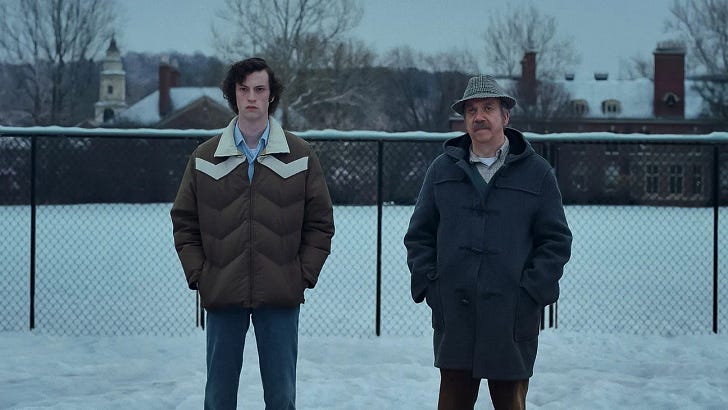
TB: This is the second time you’ve directed a film that you haven't written.
AP: Correct.
TB: Is there any anxiety about letting that go?
AP: No, it's a relief! Let me just say, if AI could write a script for me, I would be so happy. But the process was different between the two writers, if you’re interested. The Bob Nelson script on “Nebraska” was already fully formed when it reached me. I got under the hood a little bit myself, but he had come up with that and conceived it. This was different because I asked the writer to write this and then developed the story with him. And then he was off to the races.
TB: Did you give him notes or anything?
AP: Constantly did my own rewriting. Of course I'm going to get under the hood. But I'm so grateful for all the stuff he came up with that I never could have come up with, such as the cook. I had gotten as far as this disliked teacher and a group of boys, and in particular one boy. And he figured out how to peel the other boys off, as deus ex machina as that might be. And then he said, well, who would be cooking for them? Who might she be? And he came up with what her poignant situation in life is. And together we settled on 1970. Not the ’50s, because that's been done. It couldn't be a contemporary film because everything's pretty much gone coed now. We just settled on 1970 because we thought it'd be a cool time to recreate, and it gave the screenwriter stuff to work with. I mean, just the Vietnam War alone gives stakes to the characters on a nuts and bolts level. Then I thought it’d just be delightful to make a period film. I'm a history student at Stanford, I've always wanted to make period films, just hadn't yet. And now I don’t want to go back.
TB: Were there any particular challenges to doing a period film? Because it's your first one, right? Although “Downsizing” is a totally invented world.
AP: Yeah, that's different. This was more fun than “Downsizing.” The big thing for me was, first, the decision to say we're not making a period film. We're pretending we're in 1970 making a low budget contemporary film. And the production design has to feel as found and banal and accurate as if we were making a contemporary film in 1970. I accuse many period films of overdoing it in the design to convince you how “period” it is. The magnitude of that effort takes me out of the movie.
The good news is that the production designer and I shared that esthetic. I always want my sets to look as though there had never been a production designer there, like a documentary approach. And we had a really good location artist, Kai Quinlan. Technically a “location scout,” but I would call her location artist or czarina, who read the script and already had in her brain a number of places to show us from knowing the state so well, and then found other places that really were convincing and that were there in 1970.
TB: What did you do to the footage in post-production? Because it does feel like it was a movie that was made in 1970 on film, even though it was shot digitally.
AP: We shot tests on film, both on 35 and 16, and determined that because we were going to have to do so much work in post[-production] anyway, and since modern film stocks are so tight and so finely grained, why not shoot digitally? We’re going to have to do the same stuff to it anyway after the fact. So “after the fact” was at a lab in New York called Harbor, and the grain products that they have now are much more accurate than they were ten years ago when I put grain on “Nebraska.” The product they have now interacts with how much light is in each frame, and is just more accurate. And then they put in a little gate-weave so the image moves a bit and another product softens the lines a little bit so it's not lines like you get in digital and, of course, adding positive and negative dirt.
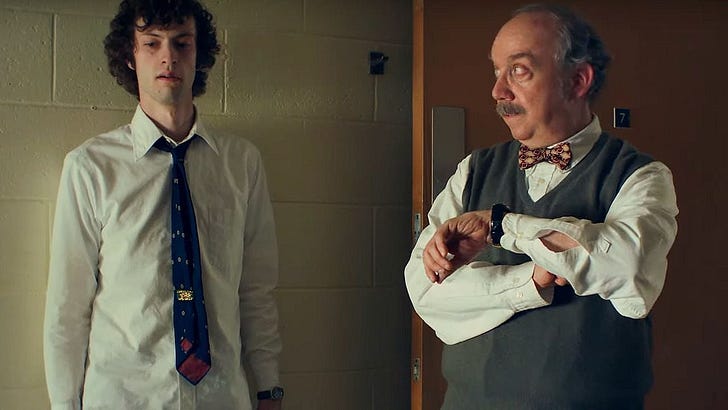
TB: Talk to me about the cast. Is Giamatti the first person you've worked with twice, aside from June Squibb? She’s the only other person I could think of.
AP: Laura Dern has a tiny cameo in “Downsizing.” But in a major part, where I had a partnership with the actor in one film and then did another? Yeah, he's the first one.
TB: Is there a shorthand that you two get going?
AP: Very short. The people on camera, the key grip and the gaffer and first assistant cameraman, commented that they’d seen shorthand between a director and an actor before, but not quite that short. I mean, it was often just monosyllables or grunts. “Say, Paul, can you --?” “Got it.” That's all we need.
Here's the deal. As a director, you want everybody around you thinking like a director to some degree – having the big picture of what film it is we're making, even though each person has his or her own bailiwick. Paul knows what movie's being made and knows how to do his job within it really well. He thinks like a director and an actor. And then he's just such a talented actor. Anyway, sorry, longwinded way of saying we have a very good shared concept of the movie we're making, and he just gets it.
And then – now, here's a phrase I've said in a couple of interviews before – for me, he's the perfect vessel of tone. The kind of tone I want in the movie, which is dramatic things with comic panache and comic things with utter seriousness. I just think he's a phenomenal movie star actor with no comps. Like when you're buying a house, what are the comps? Getting financing with Paul Giamatti in the lead, [you sometimes hear], “Well, you know, he's not a movie star.” I'm sorry, he is a movie star. He's not one of the muscle-bound goyim named Chris and Ryan. He's unique, like Lon Chaney or Charles Laughton or, or Paul Muni. Somebody who can just do anything.
TB: You wonder what somebody like that would have done in the Studio Era.
AP: A hundred percent. How about Edward G. Robinson? Who’s not Clark Gable, not Gary Cooper, but is a movie star. With no comps. Paul is Paul.
TB: And so you're working with this guy opposite an absolute newbie, 19-year-old Dominic Sessa. Tell me about him.
AP: A miracle. Minor miracle. Finding the right guy for the job. The hour was growing late. It was maybe four weeks before shooting started.
TB: Do you rehearse?
AP: Not too much. He was an actual senior at Deerfield, playing a junior, basically, at Deerfield. And after turning our noses up at 800 submissions –
TB: All professionals?
AP: Oh, God, no. Look at casting nowadays. I can just put myself on tape and upload it and press send, so these poor casting directors are deluged with stuff. And the good ones, you still look at them all, because you never know when that rose in the snow is going to show up, right? But we hadn't found him. We called up the drama departments of the schools where I was going to be shooting, and that’s how we found Dominic. He's now a sophomore at Carnegie Mellon. Born to be an actor. But he had no idea he was going to get this big career so soon. And I got a watchable movie out of the deal. I mean, if he hadn't been right, it wouldn't be the same movie.
TB: What did he think when he learned he was going toe to toe with Paul Giamatti?
AP: He was ready. That's part of his talent. He was unintimidated by the audition process. For me to convince myself that he was the right guy, I had to bring him in maybe seven times, just to see how bulletproof he was. He had never even auditioned for a movie before, so in his early auditions he was both a little nervous and thought he had to perform something, and his choice was wrong – it was too performative. So to break the mustang a little bit I had to say just calm the f down and don't act. Be and behave. Don't show me – we'll find it. But he got it really soon, and Paul and I were only too happy – especially Paul – to give him film acting tips along the way. He just fell right into it, like out of the brain of Zeus, and he was good technically. I'd never seen it before.
TB: What's his background? Where's he from?
AP: Half Italian American from Ocean City, New Jersey. His father is deceased. He has a wonderful mother who's an educator, and he has a sister who lives in Pittsburgh and is a ballerina. So they tend toward the arts in that family. And just a nice kid. I've had now almost two years for me and everyone around him to say, “don't get screwed up by this” and to try to surround him with an atmosphere so he doesn't mess up this opportunity he's about to have or let himself get messed up by it.
TB: He has an agent now, I'm assuming.
AP: And a manager. Here's a guy who's no one's even seen in a movie until a week ago.
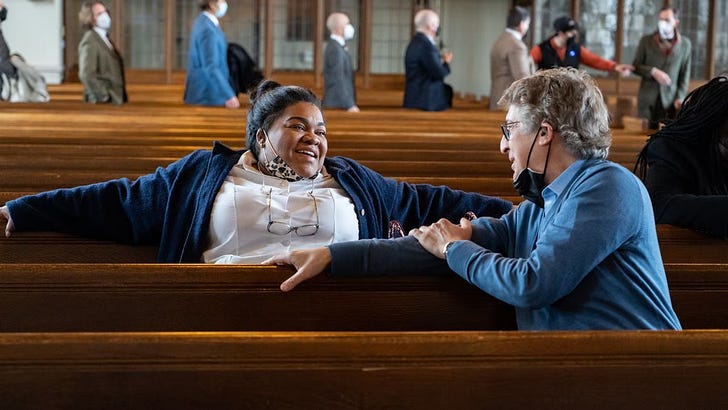
TB: And Da’Vine Joy Randolph, how did you come to cast her?
AP: I had seen her in “Dolomite Is My Name.” I love that movie.
TB: That bar scene with her and Eddie Murphy. Perfect.
AP: Among, I don't know, 30 actresses I met for that part, I had asked for her by name. I said, “Just find me that gal who was in ‘Dolomite,’ I want to meet her.” So we spoke for an hour on Zoom, and everything she said was right, especially when she said, “This script reminds me of Chekhov.” Oh, well, here, step into my office, young lady. And then she did a sample reading and I knew it was she. One of the reasons I wanted to meet her was that I like to have actors with comic chops in dramatic parts, and she fit the bill.
[We had] a phenomenal number of local Boston actors, if that's of interest to you, like, Nahim Garcia, who plays Danny, the janitor, Mary’s love interest. [Melissa McMeekin,] the wonderful actress who plays the hooker at the bookstore. [Pamela Jayne Morgan,] the wonderful actress who plays the waitress toward the end who refuses to bring cherries jubilee to the table. The wonderful actor Stephen Thorne, who plays Angus Tully's mentally troubled father – a Boston actor. All these people through Lisa Lobel at Boston Casting.
TB: It's an incredible talent pool. Is this your first time shooting in Massachusetts?
AP: Yes. Nor did I know from New England very much at all before making this movie.
TB: It was a good experience?
AP: A great experience. I call [people here] Eastern Midwesterners — chatty, frank. Hilarious. And it's the first time I've been with a local crew, including Toronto and Hawaii, where I've really stayed in touch.
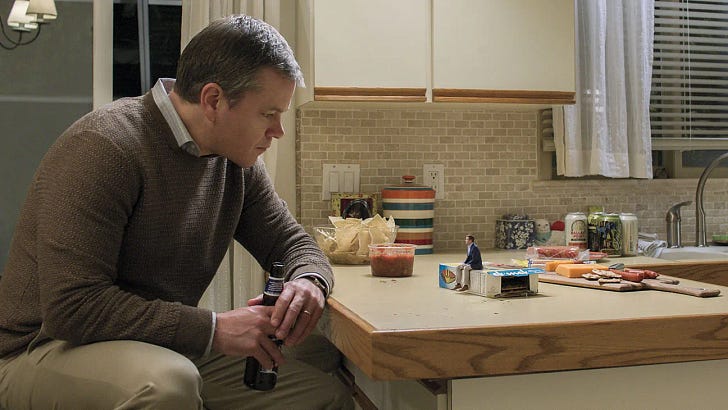
TB: Let me ask you about “Downsizing,” which was not particularly well received.
AP: Oh, it tanked. I was captain of the Lusitania on that one.
TB: Well, it was a different kind of project for you. Do you feel like it was a misunderstood movie?
AP: My joke is that in 600 years, when people really are small, it will be hailed as a masterpiece, and I will be worshiped as a god. Of course it smarts and you lick your wounds, and of course all you tell yourself is Next. After a success or a failure, it's just Next. But I saw it again a few months ago in Greece, at an environmentally themed festival. I hadn't seen it since 2017, and I think now that it's an idea better served by a limited series than by a feature film. It's like 15 pounds of sausage in an eight-pound casing. So the changes of tone that the film was accused of having might have been more easily forgiven had it been the next episode.
And the other thing, too, that I thought was not a flaw but a characteristic is that it's being sold as a commercial movie but the filmmaker is more interested in the details of life. Wait, where are my big laughs? Well, I'm kind of more interested in this Vietnamese woman. Hong Chau's performance, first and foremost, I think that's one of the best performances in any film. And the sequence early on where Matt Damon is downsized, yeah, that's pretty good. And the music is very good in the film. It has some good elements in it.
TB: What is next for you? Are you and Jim Taylor still working together?
AP: We've been chipping away at a project I would make in Paris in the French language. We're talking about the sequel to “Election,” written by Cambridge-based Tom Perotta. We haven't quite nailed down what our angle on that story would be, but that's possibly in the near future. So, yes, we still work together. And then Hemingson, who wrote “The Holdovers,” and I are conceiving a Western. I've always thought my true destiny is in Westerns. You can see traces of it in “Nebraska.” It's like a dry run for later.
TB: Last question: Every movie that comes out of the fall festival market hype gets labelled, and the label for “The Holdovers” seems to be “Alexander Payne returning to form,” “a classic Alexander Payne film.” And it got me to wondering, is there such a thing as a classic Alexander Payne film? What do you even think when you hear that?
AP: I hope it just means good quality. Well, my ego wants to think that means good quality. But that's not for me to say. I'm just interested in the act of making a movie. This one was the next one that was ready.
TB: It does seem that you're drawn to difficult characters.
AP: Well, who's a good easy character? In anything that's interesting? Claudette Colbert in “It Happened One Night” – she's pretty difficult. Rick Blaine [in “Casablanca”]. He's pretty difficult. Ben-Hur. He had a lot of shit going on in his life. Alex in “A Clockwork Orange”? Don't get me started.
“The Holdovers” expands to theaters outside New York and L.A. this Friday.
Comments? Please don’t hesitate to weigh in.
If you enjoyed this edition of Ty Burr’s Watch List, feel free to pass it along to others.
If you’re not a paying subscriber and would like to sign up for additional postings and to join the discussions — or just help underwrite this enterprise, for which the author would be eternally grateful — here’s how.
You can give a paid Watch List gift subscription to your movie-mad friends —
Or refer friends to the Watch List and get credit for new subscribers. When you use the referral link below, or the “Share” button on any post, you'll:
Get a 1 month comp for 3 referrals
Get a 3 month comp for 5 referrals
Get a 6 month comp for 25 referrals. Simply send the link in a text, email, or share it on social media with friends.
There’s a leaderboard where you can track your shares. To learn more, check out Substack’s FAQ.



